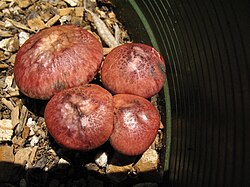Gymnopilus
| Gymnopilus | |
|---|---|
 |
|
| Gymnopilus luteofolius | |
| Scientific classification | |
| Kingdom: | Fungi |
| Division: | Basidiomycota |
| Class: | Agaricomycetes |
| Order: | Agaricales |
| Family: | Strophariaceae |
| Genus: |
Gymnopilus P.Karst. |
| Type species | |
|
Gymnopilus liquiritiae (Pers.) P.Karst. (1879) |
|
| Diversity | |
| c. 200 species | |
Gymnopilus is a genus of gilled mushrooms within the fungal family Strophariaceae containing about 200 rusty-orange spored mushroom species formerly divided among Pholiota and the defunct genus Flammula. The fruit body is typically reddish brown to rusty orange to yellow, medium to large, often with a well-developed veil. Most members of Gymnopilus grow on wood but at times may appear terrestrial if the wood is buried or decomposed. Members of Pholiota and Cortinarius are easy to confuse with Gymnopilus. Pholiota can be distinguished by its viscid cap and duller (brown to cinnamon brown) spores, and Cortinarius grows on the ground. Beginners can confuse Gymnopilus with Galerina, which contains deadly poisonous species.
The Gymnopilus genus has over 200 species worldwide.
The name means naked pileus.
Fourteen members of Gymnopilus contain psilocybin, although their bitter taste often deters recreational users. These species include G. aeruginosus, G. braendlei, G. cyanopalmicola,G. intermedius, G. junonius, G. luteofolius, G. luteoviridis, G. luteus, G. purpuratus,G. subearlei,G. subpurpuratus,Gymnopilus validipes and Gymnopilus viridans. Subspecies of G. junonius from Japan are reported to contain psilocybin, while some western North American members are inactive.
...
Wikipedia
